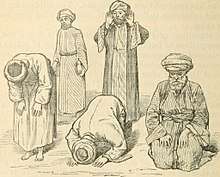Rakat
A rakat,[1] or rakʿah (Arabic: ركعة rakʿah, pronounced [ˈrakʕah]; plural: ركعات rakaʿāt), consists of the prescribed movements and words followed by Muslims while offering prayers to Allah. It also refers to a single unit of Islamic prayers.
| Part of a series on |
| Islamic jurisprudence (fiqh) |
|---|
 |
|
| Islamic studies |

Procedure
After performing the ablution, and evoking the intention to pray for the sake of Allah, the worshipper will stand quietly while reciting verses of the Qur'an . The second part of the rakat involves bowing low with hands on knees, as if waiting for Allah's orders. The third movement is to prostrate oneself on the ground, with forehead and nose on the floor and elbows raised, in a posture of submission to Allah. The fourth movement is to sit with the feet folded under the body. In the concluding portion of the prayers, the worshiper recites "Peace be upon you, and Allah's blessing" once while facing the right, and once while the face is turned to the left. This action reminds Muslims of the importance of others around them, both in the mosque (if the prayer is being offered at mosque), and in the rest of the world. The worshipper will also do it to the recording angels on his left and right as a greeting to them. [2]
Prescribed iterations
Each daily prayer has a different number of rakats per prayer:
- Fajr — The dawn prayer: 2 rakat sunnat + 2 rakat fard
- zuhr — The midday or afternoon prayer: 4 rakat sunnat then + 4 rakat fard + 2 rakat sunnat (followed by optional 2 rakat nufl)
- Asr — The evening prayer: 4 rakats sunnat and then 4 rakat fard
- Maghrib — The dusk prayer: 3 rakat fard + 2 rakat sunnat (followed by optional 2 rakat nufl)
- Isha — The night prayer: 4 rakat fard + 2 rakat sunnat then 3 rakat witr (Optional: 4 rakat sunnat prior to the 4 rakat fard. 2 rakat nafl before and after the witr)
Regarding Jumu'ah (Friday) prayers, this consists of 2 fard rakats after the Imam delivers the khutbah (followed by + 4 rakat sunnah then +2 rakat sunnah). There are two Eid prayers in a year, Eid-ul-fitr and Eid-ul-adha.
See also
Notes
- Only performed in the first rakat of the prayer and only performed by some schools.
- Only first half of the Tashahhud is recited in the second rakat in a 4- or 3-rakat prayer, e.g. the afternoon prayer or the evening prayer, but all of it is recited in the last rakat of any prayer.
- Only performed in the last rakat of a prayer.
References
- "Quran-Islam.org - True Islam". www.quran-islam.org. Retrieved 2016-02-20.
- Taslim
